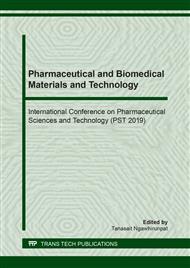p.27
p.33
p.38
p.45
p.51
p.57
p.63
p.73
p.79
Polymethacrylates as Polymeric Film Formation in Patches Containing α-Mangostin and Resveratrol
Abstract:
Polymethacrylates polymeric film formation in patches containing α-mangostin and resveratrol were developed using solvent casting method. Eudragit® E100 (E) and Eudragit® L100 (L) were dissolved in ethanol and the plasticizer (propylene glycol (PG) and polyethylene glycol (PEG) 400) was individual added and followed with the drying process. The dried films were evaluated for the morphology and flexibility. After the stable film was achieved, the α-mangostin and resveratrol were incorporated into the film. The variation of weight and thickness, swelling property, pH surface, mechanical properties and drug content of patches was evaluated. Fourier transform infrared spectrophotometry (FT-IR) was also conducted to confirm that drugs were qualitatively loaded into the patches. The results indicated that patch of L and PG was found to be stable. PG enhanced the flexibility of patch. The patches were less variation in weight and thickness. This patch did not effect to the physiological pH in the human body. In addition, patch had a tensile strength high enough to withstand tearing during handing. The qualitative and quantitative analysis indicated the α-mangostin and resveratrol was well incorporated in this patch. These results suggest that polymethacrylate polymer could be a promising polymeric film formation in patches for drug delivery.
Info:
Periodical:
Pages:
51-56
Citation:
Online since:
August 2019
Authors:
Keywords:
Price:
Сopyright:
© 2019 Trans Tech Publications Ltd. All Rights Reserved
Share:
Citation:


